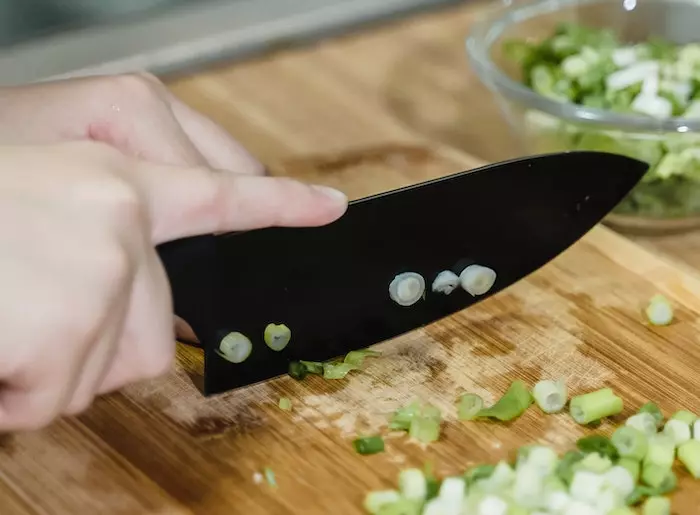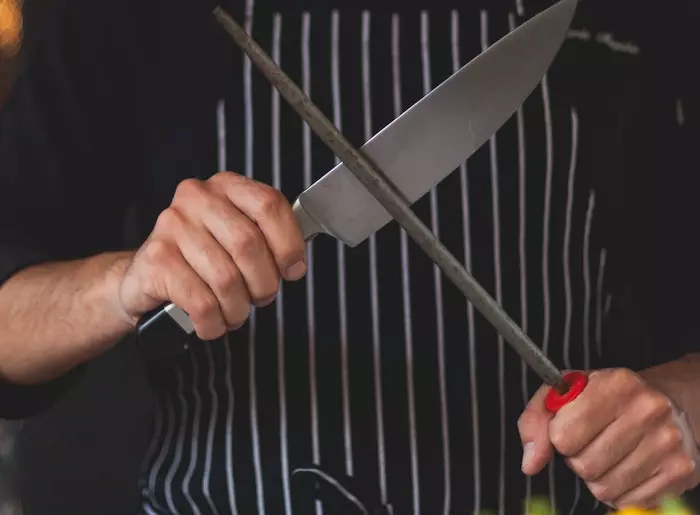It is usual for knives to become dull from frequent use, but some practices speed up the dulling process. To make your knives fully functional, you must be aware of and avoid these dulling practices.
To prevent your knife from getting dull easily, you must cut it on the right surface, wash it by hand, store them properly, hone it, use your knife for its intended purpose and use proper sharpening techniques.
This article will guide you on how to prevent your knife from getting dull easily. Let’s get into it!
- Cut On the Right Surface
- Wash by hand (Avoid Dishwasher)
- Store Them Properly
- Hone, Hone and Hone
- Use the Knife for Intended Use
- Proper Sharpening Technique
Cut On the Right Surface
Cutting on hard and rigid surfaces like marble, glass, ceramic, and stainless steel wears down the blade and quickly loses its sharp edge. Instead, use wood, polythene, or plastic chopping boards. Frequently chopping on these hard surfaces dull even knives with the best edge retention properties.

Moreover, you should avoid scraping your knives on the chopping board. So many people use knives to gather tomatoes, herbs, or onions from the chopping board without realizing the effect on the edge.
In addition to making your knives dull, scrapping on the board messes with the alignment of the blade. To prevent these damages, invest in a bench scraper.
Wash by hand (Avoid Dishwasher)
A dishwasher will clean your knives faster and properly but at the expense of a sharp edge. The water pressure, soap detergent, and heat dull the blades very quickly. Therefore, if you do not want to keep sharpening your knives, wash them by hand.
For the best results, ensure to clean the knives immediately after use with warm water, mild detergent, and a non-abrasive sponge or cloth.
Washing your knives by hand and drying them will prevent them from becoming dull easily and keep them in good condition longer.
Store Them Properly
Storing your knives with other utensils is another practice that makes them easily dull. If the knives are loose on the drawer, the blades will knock on other utensils and quickly dull. Additionally, you are most likely to get an injury from the knife when picking an item from the drawer.
Here are several ways to safely store your knives:
- Individual knife sheaths– knives come with a protective sheath, and you can continue to use them for storage. These sheaths ensure that the blades are not damaged by other utensils and prevent possible injuries.
- Dedicated drawer– you can spare a whole drawer and purchase a cork-lined drawer insert for your knives. If you have limited counter space, a drawer insert allows you to store your knives safely without taking up counter space.
- Knife block- a knife block is another storage option that keeps your knives sharp, but you must have enough countertop space. Knife blocks allow easy access because each knife is stored in its slot.
- Magnetic knife strip- this is a good knife storage option for people with no drawers or counter space. The knives will be very accessible, and they will remain sharp for a long time.
Hone, Hone and Hone
Most knife sets come with a honing rod, a long metal stick used to sharpen steel. Honing your knife frequently prevents them from becoming dull and realigns the edge.
To hone your knives, grab the knife with the dominant hand and the honing rod with the non-dominant hand. For perfect results, you must hold the knife at 20 degrees in relation to the rod. Move both sides of the blade across the honing rod from the heel to the tip several times.

Use the Knife for Intended Use
Another way to prevent your knife from getting dull easily is to use it only for the intended use. For instance, kitchen knives are meant for chopping, slicing, and dicing. Therefore, to keep them sharp, you should stop using them as a screwdriver, openers, levers, hammers, or tools.
In addition, do not use your chef knife to slice bread or frozen foods or cut ropes and cardboard. Instead, use a serrated bread knife and leave your frozen foods to thaw. Using knives for any other use other than the intended makes it dull faster and can also cause the blade to crack and chip.
Proper Sharpening Technique
Knife sharpening is a technique that can take you some time to learn. Although the method might be hard, the more you practice, the better you get. You must maintain the same sharpening angle for a razor-sharp edge and accurate tip.
There are three ways to sharpen your knives, and these include:
- Manual knife sharpener- this is the easiest and cheapest way to sharpen your knives. The sharpener has two slots to ensure that you get the best edge. A course slot to sharpen and a fine-grit slot to polish. A manual knife sharpener is also referred to as a pull-through sharpener.
- Electric knife sharpener- electric knife sharpeners also come with a coarse and fine grit, but the abrasives are powered to spin against the knife blade. They are more powerful and easier to use than manual sharpeners.
- Whetstone- a whetstone is a sharpening block with coarse and fine grit sides. It gives you a precise edge, but you must figure out the correct sharpening angle. Most knives should be sharpened at a 20-degree angle.
Importance of sharpening your knife with the right tools
There are many knife sharpening tools on the market, but you must figure out the best for your knives. Here are various reasons why you should use the right sharpening tools:
Ensures that a lot of metal is not taken off of the knife during sharpening
The amount of metal lost during knife sharpening depends on the grit of the sharpener. A coarse grit labeled 1000 should be used to sharpen damaged blades, medium grit labeled 1000-3000 should be used on dull blades in good condition, and fine grit 4000 to 8000 grit should be used to polish the edges.
Saves you time
The type of sharpener you use determines how much time and effort you use to sharpen your knives. A whetstone might take about five minutes to get a sharp edge, while an electric sharpener requires a few passes. Therefore, choose a sharpener depending on how much sharpening time you have.
Saves you money
Sharpening a knife with the right sharpening tools ensures that the blade does not wear out fast; therefore, the knife will serve you for a long time. This saves you money because you do not have to purchase a new set of knives frequently.
Why Does My Knife Get Dull So Fast?
Knives are expected to dull with frequent use, but some factors fasten the dulling process. Your knife will get dull faster than expected if you use it for purposes other than the intended if you cut on hard surfaces and wash it in the dishwasher, among other things.
Why Does My Knife Get Dull When I Sharpen It?
Your knife dulls when you sharpen it at very high angles. The recommended sharpening angle for most knives is 20 degrees against the sharpener. High angles speed up the sharpening process, but you will never get a razor-sharp edge.
In Conclusion, How to Prevent Your Knife from Getting Dull Easily
To prevent your knife from getting dull easily, you must take care of them. Ensure to store them properly, use them for the right purposes and hone them frequently. Moreover, rinse the knives and dry them with a towel after sharpening them to get rid of excess metal shavings.


